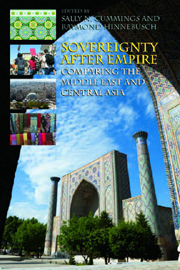Book contents
- Frontmatter
- Contents
- Acknowledgments
- Notes on the Contributors
- 1 Introduction
- SECTION I Histories of Empire and After
- SECTION II Paths to Sovereignty: Views from the Core and Periphery
- 5 Sovereignty in the Ottoman Empire and After
- 6 Mandated Sovereignty? The Role of International Law in the Construction of Arab Statehood during and after Empire
- 7 Reluctant Sovereigns? Central Asian States' Path to Independence
- SECTION III Empire and Domestic Sovereignty
- SECTION IV Empire and Popular Sovereignty
- SECTION V Empire and External Sovereignty
- Bibliography
- Index
5 - Sovereignty in the Ottoman Empire and After
from SECTION II - Paths to Sovereignty: Views from the Core and Periphery
Published online by Cambridge University Press: 12 September 2012
- Frontmatter
- Contents
- Acknowledgments
- Notes on the Contributors
- 1 Introduction
- SECTION I Histories of Empire and After
- SECTION II Paths to Sovereignty: Views from the Core and Periphery
- 5 Sovereignty in the Ottoman Empire and After
- 6 Mandated Sovereignty? The Role of International Law in the Construction of Arab Statehood during and after Empire
- 7 Reluctant Sovereigns? Central Asian States' Path to Independence
- SECTION III Empire and Domestic Sovereignty
- SECTION IV Empire and Popular Sovereignty
- SECTION V Empire and External Sovereignty
- Bibliography
- Index
Summary
As the most direct heir to the Ottoman Empire, the Turkish Republic enjoys a particular position among its fellow post-imperial states. This chapter examines the dynamic of legacy between empire and republic through the lens of sovereignty. It argues that despite its strong, sometimes extravagant desire to separate itself from the ancien régime, the early republic owed much to its imperial predecessor and shared much in common with its fellow post-Ottoman successor states. It goes on to explore comparisons with these states in order to highlight the extent to which the particular circumstances of its pathway to sovereignty resulted in a distinct profile that increasingly separated Turkey from the other newly created states, especially those that emerged in the formerly Arab provinces of the empire.
The Ottoman Empire conquered the Arab lands of Syria, Palestine and Egypt (and by extension the Hejaz and the Islamic holy cities of Mecca and Medina) in the early sixteenth century and lost them in the aftermath of the First World War. The intervening four centuries of imperial cohabitation have been marked in popular historical perception by a combination of amnesia and ill-feeling engendered only in the final years of this long time span. Writing many years ago, Albert Hourani remarked that in spite of these four centuries of shared imperial existence, the history of Ottoman, or “Turkish,” rule was largely omitted from Arab histories of this period.
- Type
- Chapter
- Information
- Sovereignty after EmpireComparing the Middle East and Central Asia, pp. 91 - 103Publisher: Edinburgh University PressPrint publication year: 2011

